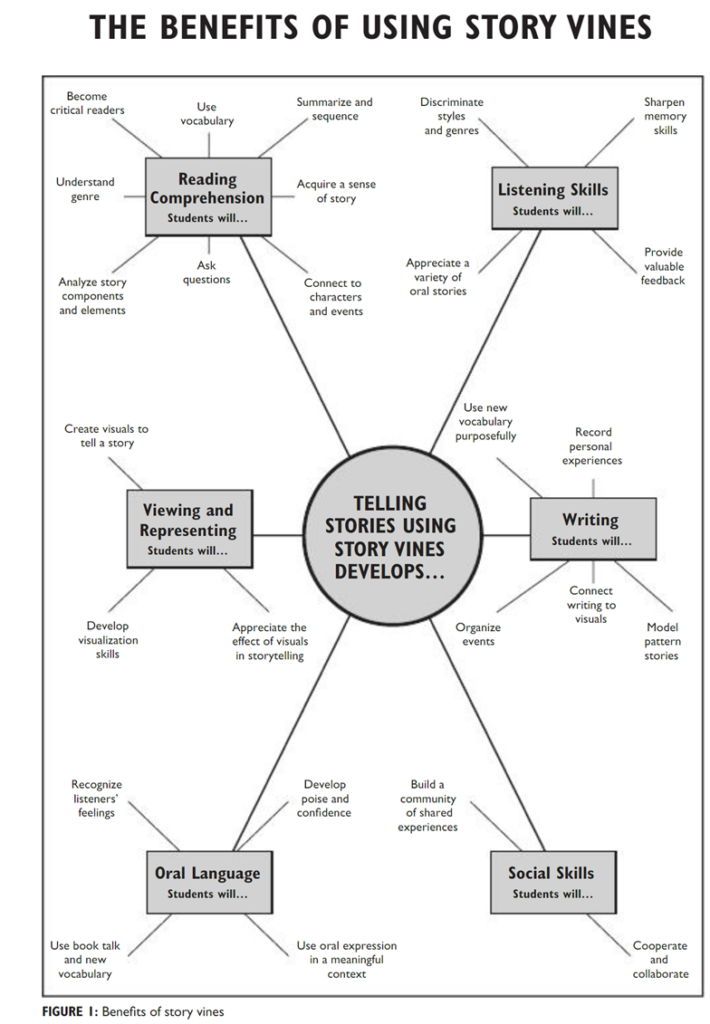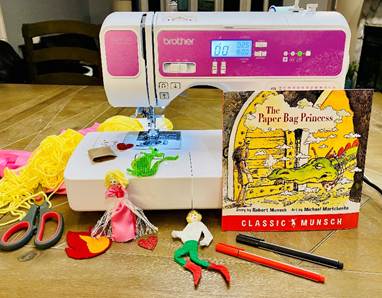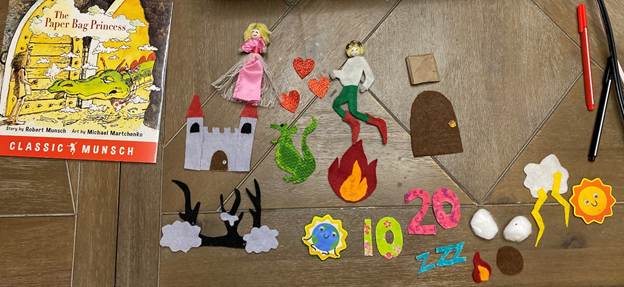History and Benefits of Story Vines
There are many advantages of using “story vines” as a creative teaching tool to enhance students’ reading comprehension and storytelling abilities. The strategy, introduced by reading consultant Marlene McKay, is based on an ancient African tradition of oral storytelling (Bright, 2021). Story vines encourage students to visually represent stories using pictures and figurines, which not only helps them recall and retell stories but also deepens their understanding of the material, without relying on written words.
There are many benefits of story vines beyond improved literacy; story vines offer a way to incorporate indigenous perspectives into the classroom. As highlighted in a March 2019 article by Shannah-Lee Vidal, teachers have begun using this technique to celebrate indigenous culture and traditions (CBC, 2019). This approach allows students to connect with stories on a more personal level and encourages them to explore diverse cultural narratives. It also creates a bridge between the oral traditions of indigenous cultures and modern educational practices.
The versatility of story vines makes them suitable for students of all ages and learning styles. Whether in early education or upper grades, story vines can be adapted to meet different learning outcomes and accommodate a wide range of abilities. The activity encourages creativity, fosters memory retention, and allows students to engage in meaningful classroom discussions. By collaborating with peers to create their own story vines, students also build teamwork and communication skills, making the learning process both interactive and collaborative. Story vines offer a dynamic, culturally rich tool for enhancing literacy, fostering inclusivity, and supporting diverse learning needs in the classroom. McKay lays out a great web of the benefits of story vines in her book, Story Vines and Readers Theatre: Getting Started which is shown below.

How to Create a Story Vine



Repetition is important. The more opportunities students have to share their story vines with others, the more their confidence will grow in language fluency, vocabulary, and comprehension
Robin Bright
In addition to these steps that have been laid out by Bright, I would use a story planning sheet to help students design and plan their story vine prior to create it. I created a sheet on Canva for students to draw out their characters or symbols to represent their book on their story vine. The planning sheet could include a simple drawing or sketch, or go more in depth to help students plan out design and colours. In addition, students could write a few brief sentences to help represent the story that each story represents before they are able to move to the retelling stage with no written words. This process could be adapted based on students’ ability or academic level to ensure that the activity remains relevant to the students learning.


My Story Vine

I really enjoyed making my story vine. I started by wanting to create a few characters at home and the next thing I knew I had created all my characters and symbols! I chose to use The Paper Bag Princess by Robert Munch as a classic story to recreate for students. I loved how this activity allowed me to engage in my creative side while helping me to recall and retell the story. While creating my story vine I went through the book a few times to ensure that I was capturing key moments of the story. This is where it would have benefited me in using a planning sheet such as the one, I created for my students.

Future Use for Story Vines
In my upcoming practicum, I plan to incorporate story vines as part of our novel study on My Name is Parvana by Deborah Ellis. Story vines will be used to help students understand key events and themes in the book, such as gender roles, resilience, and survival. I envision having students choose specific chapters to retell using story vines, highlighting cause-and-effect relationships and enhancing their comprehension of the plot. By connecting Parvana’s present experiences with flashbacks to her past, students can track her emotional and character development throughout the story. These visual tools will also allow students to explore the author’s message, particularly on gender equality and the impact of conflict on individuals. As students share and discuss their story vines, they’ll be able to deepen their understanding of the novel’s themes, making connections to both the character’s growth and the broader world issues. Story vines will be an engaging and effective way to promote critical thinking, creative expression, and reflection on the novel. What is even more exciting is that when I mentioned wanting to do a story vine to my mentor teacher, she had never heard of them! I am excited to bring something fresh and new to her classroom.

Looking further into the future, I plan to use story vines as a versatile tool to enhance student learning across various subjects and grade levels. Story vines will allow students to visually map out key events, characters, and themes in texts, helping them connect ideas and understand cause-and-effect relationships. By creating story vines, students will be able to break down detail narratives, track character development, and explore the underlying messages in a story. This tool can also be used in group activities, encouraging collaboration and discussion as students share their interpretations through a multitude of cross curricular subjects, such as history or science, where students can outline processes, timelines, or relationships between concepts. I thoroughly enjoyed making my story vine and found it to be an engaging and interactive way to foster critical thinking, creativity, and deeper comprehension that will be imperative in future classrooms.

Resources
Bright, R., 2021. Sometimes Reading Is Hard, Pembroke Publishers. Markham, CA. Retrieved from https://coilink.org/20.500.12592/jxm425 on 12 Feb 2025. COI: 20.500.12592/jxm425.
McKay, M. (2008). Story vines and readers theatre: Getting Started. Portage & Main Press.
Vidal, S. (2019, March 2). Winnipeg teachers learn how to weave colourful fabric into stories. CBC. https://www.cbc.ca/news/canada/manitoba/story-vines-winnipeg-1.5040107





